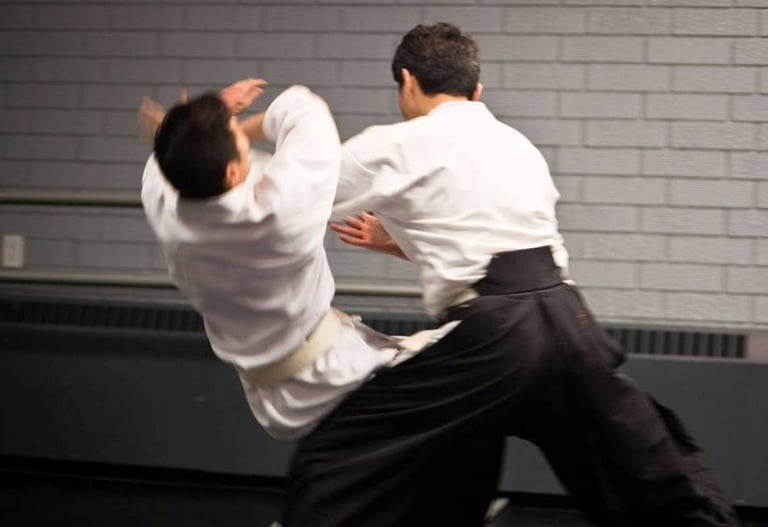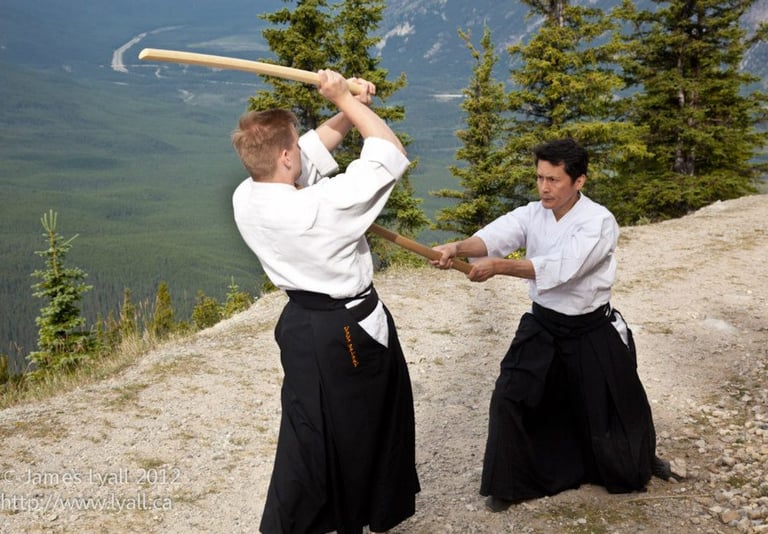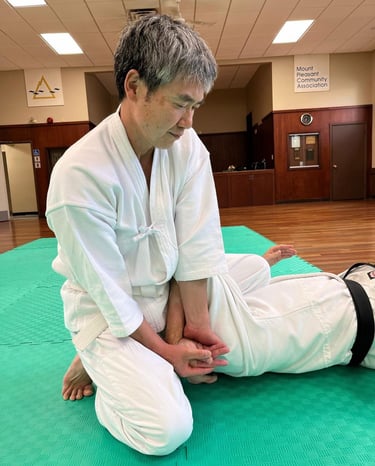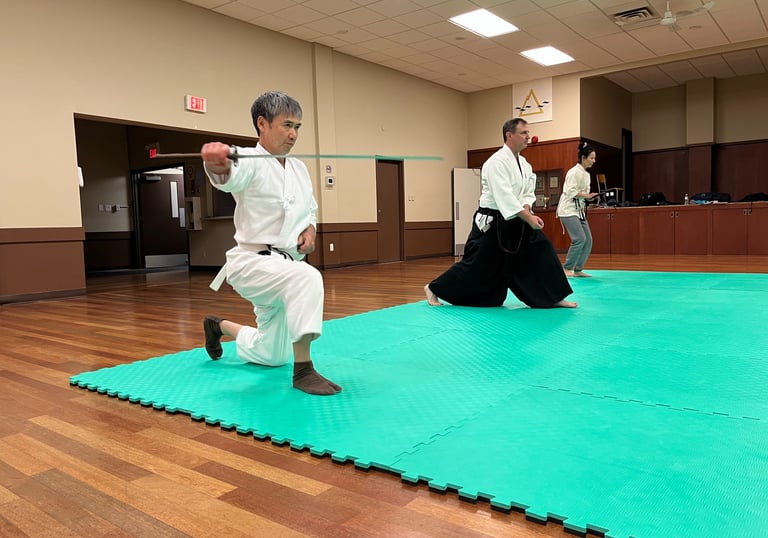Our Practice – Traditional Martial Arts of Calgary Rakushinkan
At Calgary Rakushinkan we practice Aikidō and Kobudō — martial arts of both the modern and classical periods.
Aikidō, Kenjutsu, Daitō-ryū, and Iaijutsu are studied not in isolation but as interconnected expressions of one purpose. Each art reveals principles that echo through the others, creating a unified path of movement, awareness, and intent.
Aikidō emphasizes softness, natural connection, and flowing movement. Rather than meeting strength with strength, techniques guide an opponent’s energy into balance-breaking and resolution. Our approach avoids rigid kata or staged demonstrations, focusing instead on whether a technique genuinely works through timing, sensitivity, and centred movement. This style nurtures calmness, adaptability, and the ability to move harmoniously under modest pressure.
Learn more about Rakushinkan Aikido.
The traditional art of Japanese swordsmanship practiced by the samurai. Training develops timing, distancing, and cutting methods through kata (forms) and paired practice. Kenjutsu not only preserves battlefield and duelling techniques but also teaches posture, precision, and focus that influence all other martial skills.
Learn more about our kenjutsu.
Daitō-ryū Aikijujutsu is the ancestor art of Aikidō. It emphasizes close engagement, subtle kuzushi (breaking balance), and precise control at the moment of contact. It preserves the essence of classical jujutsu: detailed joint locks, immobilizations, and refined use of aiki. Training develops the ability to unbalance an opponent with minimal effort, relying on connection, structure, and timing rather than physical force. This practice reveals the roots of Aikidō while maintaining the direct, practical effectiveness of the older tradition.
Learn more about our Daito Ryu.
Iaijutsu is a traditional Japanese martial art focused on drawing the sword and cutting in a single motion. Its practice emphasizes timing, precision, and awareness, using kata to train smooth and decisive technique. Unlike kenjutsu, which begins with the sword in hand, iaijutsu centers on responding instantly as the blade leaves the scabbard.
Learn more about our iaijutsu.
There are many places to practice Aikidō, but few where you can study its roots and weapons training together as an integrated system.
Ready to train? Visit our Schedule, meet our Instructors, and Sign up!
The Relationship of the Four Arts
At Rakushinkan, Aikidō, Daitō-ryū, Kenjutsu, and Iaijutsu are studied as one integrated system of budō. Each art illuminates the others, expressing the same underlying principles through different forms of practice.
“Kenjū Ittai” — Sword and Jūjutsu Are One
The same principles governing sword movement (cutting lines, distance, timing, body alignment) are embodied in empty-hand technique. In other words — Kenjutsu and jujutsu are two sides of one principle of aiki.
Iaijutsu as the Link Between Ken and Jū
Iaijutsu is the art that binds Kenjutsu and Jūjutsu. Where Kenjutsu trains outward interaction and timing, Iaijutsu refines inward composure, readiness, and spontaneous movement — the moment between stillness and action. Iaijutsu connects inner awareness and outer expression — it teaches how the same center governs both sword and body.
Daitō-ryū as the Source of Aiki
Daitō-ryū Aikijūjutsu provides the structural and mechanical understanding of aiki — the integration of breath, timing, and subtle control.
It is through Daitō-ryū that the principles of aiki are transmitted, while sword work reveals them.
“Aiki’s form in the body was systematized as Daitō-ryū; its essence was drawn from the sword.” (合氣の体現は大東流に伝わり、その理は剣に発す。)
Aikidō is a modern expression built upon this integration — an outgrowth that refines the spirit rather than the combative form.
Aikidō as the Expression of Unity
In the Rakushinkan view, Aikidō represents the external expression of these combined principles — where ken (sword), iai (drawing), and jū (grappling) converge into unified body movement and intent.
“The circle of Aiki completes itself when sword, body, and spirit move as one.” (剣・体・心が一つに動く時、合氣の円が成る。)
Thus, the four arts aren’t separate studies:
Kenjutsu gives the form of aiki.
Iaijutsu gives the readiness and inner connection.
Daitō-ryū gives the structure and principle.
Aikidō gives the manifest expression.
Together they form one continuous budō transmission.
Some FAQs on our martial arts
Calgary Rakushinkan martial arts - Is it like karate?
Yes and No. We both wear similar white pajamas.
Karate tends to focus on stricking and kicking. The practice long forms/patterns (kata) of solo practice to build their body and strong stances to generate power. Often there is a competitive aspect or sparring or kata performance.
Our martial arts of AIkido and Daito Ryu are a type of jujutsu. It's almost exclusively hands-on partner practice where the defender deals with the attackers grab or strike. We focus on disbalancing (kuzushi) the attacker, controlling and submitting him/her. This practice also includes disarming armed attachers (knives, small arms).
We also practice related weapon arts of kenjutsu (sword fighting) and iaijutsu (sword drawing ) and more. Karate is exclusively empty hand (Karate do = "Way of the Empty Hand")
Instructor Josh MacDonald has some authority on the subject with karate being his first art, which he trained in for for over 20 years.
What about Taekwondo?
An oversimplified answer might be "Taekwondo is Korean karate," but it is not far off.
Taekwondo is a Korean martial art who's practice consists mainly of forms and sparring (and competition). The spirit is very much similar to karate, but tends to have more emphasis on flexibility, kicking and dynamism.
How is Calgary Rakushinkan martial arts different from jiu-jitsu or BJJ?
All of these are different forms of jujutsu. There's an article about jujutsu on our article page.
Aikidō/Daito Ryu and jiu-jitsu share older jujutsu roots, but their methods and purpose differ. Modern BJJ focuses on ground control and competition. It's an exponent of Judo which focuses more on throws than groundwork and also involves a lot of competition. (note that BJJ stands for "Basically Just Judo" 😄)
Aikidō and Daito Ryu come from older samurai jūjutsu systems and emphasize staying upright, blending with attacks and controlling opponents. At Calgary Rakushinkan we preserve that classical budō approach — training for precision, calmness, and connection rather than points or wins.
Again, our methods are broad and robust given the amount of integrated weapons training.
Are Calgary Rakushinkan martial arts suitable for kids? Can they use weapons?
Absolutely! We have a dedicated kids’ Aikidō program designed to build focus, coordination, and confidence through structured movement and partner practice.
Because there’s no competition, children learn respect and discipline while improving posture and attention — all within a safe, positive atmosphere.
The amount of sword or weapon practice depends on the child’s age and awareness. Ultimately, all of our arts are rooted in sword movement.
What makes traditional martial arts different from modern combat sports?
Traditional martial arts like ours - and others like Karate, Kung Fu, Taekwondo, etc - emphasize lifelong development — posture, awareness, and ethical use of skill. Combat sports prioritize competition. Both build strength and focus, but the goal of traditional martial arts is mastery, not victory.
Read more on our philosophy.
Which martial art is best for beginners — karate, jiu-jitsu, Aikidō, or kenjutsu?
Of course we're the best.😄
No, for a beginner, the best martial art is the one that suits them and has Sensei (instructor) and group that they like.
Is there a free trial class?
Yes of course. We recommend participating in a few classes to get an idea of the scope of our martial arts practice and also the feel for our club and instructors prior to officially joining.
More questions answered in our FAQ. Or, feel free to contact us.
Calgary Rakushinkan
カルガリー楽心館
Experience traditional Japanese martial arts training.
© 2025. All rights reserved.
CONTACT
rakushincalgary@gmail.com
(403) 401-8257








